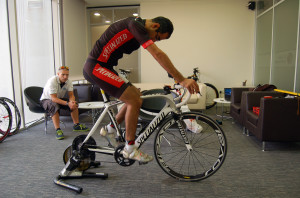Cycling has always been a great pastime, mode of transport and, of course, a tool for winning trophies and gold medals. Anyone can and should be able to get involved. It’s as easy as just walking into a shop, choosing a bike and riding away knowing that you are doing something good for yourself and the environment. But it can be complicated to enter into a new sport where the elite are just amazing and the technology can be bewildering.
Bicycles are made by manufacturers taking into account averages. They calculate average heights of people in each of the markets they serve and value the riders fit, comfort and success. They use research and racing results to build bicycles that are close to as many averages in terms of leg length, reach and bone structure as possible. It is possible that your bicycle is the “right size” for you when you are able to reach for the bars and touch the ground with your feet, but that is probably where the match of rider and bike ends.
Now, consider human body calculations. Realistically, it is necessary to understand how exactly you are built and how to adjust the bicycle to fit you. It sounds so logical, but when was the last time someone asked you if you had a varus (big toe up) or valgus (big toe down) cycling action?
Half of the bones in the human body are in the feet and legs, and they should be one of the key starting points in making adjustments and aligning the working of the mechanisms that provide human-powered propulsion. There should be a full review of your body and spinal curve, lengths and muscle mass. It’s a real eye-opener when someone is actually looking at the mechanics of your body and explaining how things work together.
Having recently completed my Specialized Body Geometry Fit training, (a service now offered at The Cycle Hub), I also became the physical test subject for the training. During this time, I was able to learn and witness firsthand the changes in my cycling comfort and performance through this system, and I’m sincerely keen to shout it to the world. Everyone should be aware that the bike needs to be fitted to them to ensure a safe, efficient and comfortable cycling experience.
Something as simple as knowing my left femur was 4mm shorter, and being able to adjust the inner sole of my cycling shoe by adding a wedge and shifting my cleat position (where you attach your feet into the pedals) allowed me a smoother action and reduced the effort my muscles were compensating for. Now, I can cycle a little further if I want to and have less tension in my leg muscles, which I used to think was caused by my left leg being weak! We also managed to remove the tension and hunching in my shoulders while riding with a stem change. We replaced the 100mm stem with an 80mm stem and made better saddle adjustment. Imagine being able to cycle 15 per cent further or longer just because you made adjustments to your own bike!
The variances become so evident when you know what to look for and the solutions always immediately show improvements.
It is no wonder that Specialized invests so much in the program with Dr Pruitt at the Boulder Center for Sports Medicine, and offers a complete range of equipment such as BG shoes, BG arch supports, BG shims, BG saddles and BG gloves to support the program.


